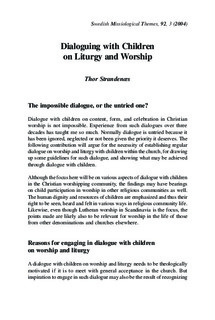| dc.contributor.author | Strandenæs, Thor | |
| dc.date.accessioned | 2010-03-14T15:26:34Z | |
| dc.date.issued | 2004 | |
| dc.identifier.issn | 0346-217X | |
| dc.identifier.uri | http://hdl.handle.net/11250/161900 | |
| dc.description | Originally published in: Svensk missionstidskrift = Swedish missiological themes, vol. 94(2006) p. 561-569, see http://www.teol.uu.se/digitalAssets/6/6175_SMT3_04.pdf | en |
| dc.description.abstract | Through evidence from Scripture, the church’s understanding of baptism and the ecumenical creeds is argued that the church recognizes baptized children as Christians, and hence as full members of the church – equal to youth and adults. In this capacity they cannot be treated as mere objects but must be considered as contributors in the life of the church. This means that children are also equal partners both in the celebration of the church’s worship and in developing its liturgies. Without them Christian worship will suffer, since the church, as the adults and youth, need the children as much as they need them. Without children as partners and contributors, the church’s worship will not be theologically legitimate and will also lose its relevance. If partnership is to function adequately, children must be engaged by the church through dialogue on worship and liturgy together with youth and adults.
Twelve guidelines for such dialogue are proposed, albeit these are not in any way to be understood as exhaustive or complete. The guidelines are based on ecumenical dialogue experience and on the insights from international work with children’s rights. The guidelines aim at securing a good and fruitful atmosphere for such dialogue. When churches engage in local dialogues, new insights are certain to follow which may supplement the twelve listed in the article.
The author also briefly outlines the expected outcome of dialogue with children on worship and liturgy, basing his predictions on five pairs of general characteristics or qualities of childhood. Only by trying the dialogue itself will the church and its local parishes discover the rich treasure which dwells in its children. Although the church needs a theological motivation for engaging in this kind of dialogue, it can equally draw inspiration from ecumenical incentives and the international human rights of children. Fortunately churches have already embarked on this new way. Such dialogue will certainly enrich and renew the church’s worship, as well as make it more holistic and secure in its theological accountability. | en |
| dc.format.extent | 466636 bytes | |
| dc.format.mimetype | application/pdf | |
| dc.language.iso | eng | en |
| dc.publisher | Swedish Institute of Mission Research | en |
| dc.subject | liturgy | en |
| dc.subject | worship | en |
| dc.subject | children | en |
| dc.title | Dialoguing with children on liturgy and worship | en |
| dc.type | Peer reviewed | en |
| dc.type | Journal article | en |
| dc.subject.nsi | VDP::Humanities: 000::Theology and religious science: 150::Theology: 151 | en |
| dc.source.pagenumber | 489-515 | en |
| dc.source.volume | 92 | en |
| dc.source.journal | Svensk missionstidskrift = Swedish missiological themes | en |
| dc.source.issue | 3 | en |
